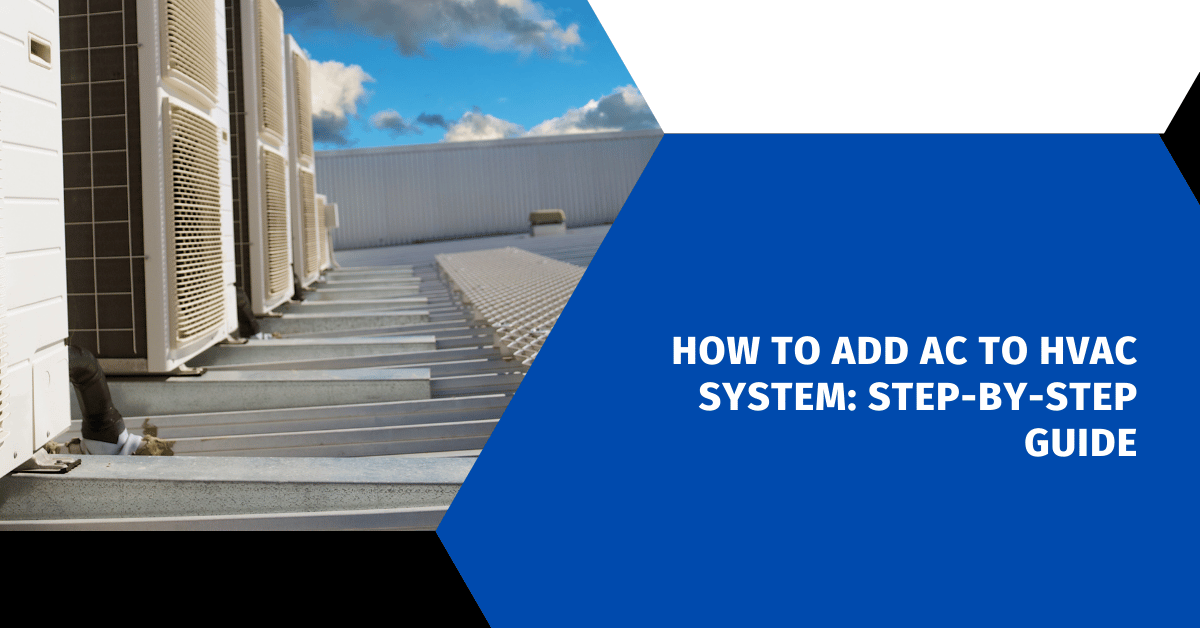Affiliate Disclosure
HVAC Guide Guys is a participant in the Amazon Services LLC Associates Program, an affiliate advertising program designed to provide a means for sites to earn advertising fees by advertising and linking to Amazon.
How to Add AC to HVAC System? Are you tired of hot summers and uneven cooling at home? Adding AC to your HVAC system might be the answer you need. Today, more homeowners want a cooling system that makes their homes comfortable.

Upgrading your HVAC system can make your home more comfortable and save energy. Central air conditioning cools your home evenly by circulating cool air through ducts.
Adding air conditioning needs careful planning and a pro’s help. This guide will help you understand how to add a central AC system to your home.
Key Takeaways
- Central AC provides whole-home cooling efficiency
- HVAC system upgrades increase property value
- Professional assessment is crucial for successful installation
- Different AC systems suit different home configurations
- Proper sizing ensures optimal cooling performance
Table of Contents
Understanding Central Air Conditioning Basics
Before you install air conditioning, it’s key to know how central AC systems work. Today, there are many cooling options for keeping your home cool and comfortable.
Central air conditioning systems cool your whole house by moving heat outside. They keep your home at a perfect temperature all the time.
Split AC Systems vs Packaged Units
There are two main types of central air conditioning setups:
- Split AC Systems: Have separate indoor and outdoor units
- Packaged AC Units: Everything is in one outdoor unit
| System Type | Indoor Unit | Outdoor Unit | Space Requirements |
|---|---|---|---|
| Split System | Separate indoor air handler | Exterior condenser | More flexible installation |
| Packaged Unit | Integrated with outdoor unit | Single comprehensive unit | Compact footprint |
Essential Components of AC Systems
Important parts make up your air conditioning system:
- Compressor: Pressurizes refrigerant
- Condenser coil: Releases heat outside
- Evaporator coil: Absorbs indoor heat
- Refrigerant lines: Carry cooling agent
- Thermostat: Controls temperature
How Central AC Works
Central air conditioning uses a complex heat transfer process. Warm air is pulled into return ducts, then cools down. This process keeps your home cool and dry.
Evaluating Your Home’s Cooling Needs
Before adding an AC unit, it’s key to know your home’s cooling needs. Choosing the right air conditioner is more than picking a random one. You need a detailed check to get the best performance and save energy.
- Square footage of your living space
- Home’s insulation quality
- Number of windows and their orientation
- Local climate conditions
- Household occupancy and daily activities
Calculating Heat Load Requirements
The Air Conditioning Contractors of America (ACCA) Manual J load calculation is key. It helps avoid mistakes when adding an AC unit to your system.
“Accurate heat load calculation is the foundation of an effective cooling strategy.” – HVAC Professionals Association
Determining Proper AC Unit Size
Choosing the right AC unit size is crucial. A unit that’s too small won’t cool your home well. A unit that’s too big wastes energy and causes uneven cooling.
Assessing Current HVAC Infrastructure
Your current HVAC system is important for adding an AC unit. Experts will check:
- Ductwork condition and layout
- Electrical system capacity
- Current system’s age and efficiency
- Potential necessary modifications
Understanding these elements ensures a successful AC installation that fits your home’s cooling needs.
Explore Our HVAC Shop
Looking for top-rated HVAC tools, parts, and accessories? Visit our shop and find the perfect solution for your needs.
Visit the ShopCost Considerations and Budget Planning
Adding central air conditioning to your home needs careful budgeting. The cost can vary a lot based on several factors. You should plan a budget that includes more than just the cost of the equipment.
Here are some typical costs for adding hvac air conditioning:
- Central AC unit: $2,500 – $4,500
- Installation fees: $3,500 – $7,000
- Potential additional expenses:
- Ductwork modifications
- Electrical system upgrades
- Permit and inspection costs
Your total cost will depend on a few important things:
- Home size and layout
- System efficiency rating
- Local climate conditions
- Existing HVAC infrastructure
To keep costs down, get quotes from different HVAC contractors. Look at detailed estimates that show what you’ll pay for equipment, labor, and extra work. Some contractors might offer financing or discounts to help with the cost.
Pro tip: Think about energy-efficient models. They might get you tax credits or rebates, which can help with the upfront cost.
If you’re watching your budget, save 10-15% extra. This is for any unexpected costs that might come up during the installation.
How to Add AC to HVAC System
Adding AC to your HVAC system needs careful planning. It involves several key steps for the best performance and efficiency. Knowing these steps helps you feel more confident during the installation.
First, you must do a thorough pre-installation check. This step is vital to see if adding AC to your HVAC system is possible and what it will need.
Pre-Installation Assessment
Your HVAC expert will do a detailed check. This includes:
- Measuring your home’s square footage
- Checking the condition of your ductwork
- Looking at your electrical system’s capacity
- Finding any possible installation problems
Equipment Selection Process
Choosing the right AC unit is important. It must match your home’s cooling needs. Consider these factors:
- Energy efficiency ratings
- Cooling capacity
- Compatibility with your HVAC system
- Your budget
Installation Timeline Overview
Installing an AC usually takes 1-3 days, depending on your home. The process includes planning, placing the equipment, and testing the system. This ensures it works at its best.
Professional installation ensures your cooling system works well and lasts long.
Selecting the Right AC Equipment
Choosing the right AC equipment is key for long-term comfort and saving energy. Your choice affects your home’s cooling and your utility bills.
Here are important factors to consider when picking an AC unit for your upgrade:
- Energy Efficiency Ratings (SEER)
- Home Size and Cooling Needs
- Climate Factors
- What You Can Spend
The Seasonal Energy Efficiency Ratio (SEER) is vital when adding AC to your HVAC system. The law requires a SEER of 13 for new AC units. A higher SEER means better energy use, which can lower costs over time.
Today’s AC units come with cool features to improve your home’s cooling:
- Variable-speed compressors for steady temperatures
- Smart thermostat support
- Less noise
- Better air filters
When you upgrade your HVAC, get help from a pro. They’ll make sure the unit fits right and works well. The wrong size can cause poor cooling, high energy use, and damage to your system.
Explore Our HVAC Shop
Looking for top-rated HVAC tools, parts, and accessories? Visit our shop and find the perfect solution for your needs.
Visit the ShopPreparing Your Home for Installation
Getting ready for air conditioning installation is a big task. Your home needs some changes for a smooth process. Planning well can save you time, money, and trouble.

- Ductwork evaluation and possible changes
- Electrical system needs
- Choosing the best unit spot
Ductwork Assessment
Check your ductwork carefully. Look out for these problems:
- Air leaks at connections
- Not enough insulation
- Dust or dirt buildup
- Wear or damage signs
Electrical Considerations
Your electrical system must handle the new unit. A pro electrician can check if you need:
- Circuit upgrades
- More electrical power
- A dedicated circuit
Optimal Installation Locations
Choosing the right spots for indoor and outdoor units is key. Think about these points:
- Shade for outdoor units
- Less noise
- Good airflow
- Easy to get to for upkeep
Pro tip: Work with a certified HVAC pro to get your home ready for a great air conditioning install.
Professional Installation Process
Adding an AC unit to your HVAC system needs professional installation for the best results. This process requires skills and knowledge that go beyond simple repairs.
Certified HVAC technicians take a detailed approach to add AC units to your home’s cooling system. They follow a few key steps:
- Comprehensive site evaluation
- Precise equipment selection
- Careful system integration
- Thorough performance testing
Installing an AC unit needs special tools and advanced technical skills. Experts use advanced equipment for correct refrigerant charging, electrical connections, and system calibration.
| Installation Stage | Key Activities | Duration |
|---|---|---|
| Site Preparation | Assess space, remove obstacles | 1-2 hours |
| Equipment Placement | Mount indoor/outdoor units | 2-3 hours |
| System Connection | Connect refrigerant lines, electrical | 3-4 hours |
| Final Testing | Performance verification | 1 hour |
Trying to install it yourself can void warranties and be unsafe. Professional technicians know local building codes, permit needs, and complex system workings. They make sure your new AC unit works well with your current HVAC system.
Professional installation ensures your AC works well and lasts longer.
Choosing a certified HVAC pro means you get reliable, efficient cooling for years.
Working with Existing HVAC Components
When you add air conditioning to your HVAC system, it’s key to know how to mix new parts with what you already have. Your home’s current heating and cooling setup affects how hard it is to add air conditioning.

Today’s air conditioning systems can often work well with your heating parts. It’s all about careful checking and planning to get the best results.
System Integration Strategies
- Assess current ductwork compatibility
- Evaluate electrical system capacity
- Determine potential modification requirements
- Check overall HVAC infrastructure strength
Ductwork Modification Considerations
Adding air conditioning to your HVAC system needs the right ductwork setup. Technicians will look at your duct system to see what changes are needed.
| Ductwork Aspect | Potential Modification | Impact on System |
|---|---|---|
| Duct Size | Resize or Replace | Improved Airflow |
| Insulation | Add/Upgrade | Enhanced Efficiency |
| Seal Integrity | Repair Leaks | Reduced Energy Loss |
Getting help from pros when adding air conditioning ensures it fits well with what you already have. Good planning helps avoid problems and makes your system work better.
Explore Our HVAC Shop
Looking for top-rated HVAC tools, parts, and accessories? Visit our shop and find the perfect solution for your needs.
Visit the ShopSolutions for Homes Without Ductwork
Upgrading HVAC for AC can be tough in homes without ducts. Luckily, new tech offers cool solutions for almost any home.
Two main options for ac integration with hvac in ductless homes are:
- Ductless Mini-Split Systems: Highly flexible cooling solution
- High-Velocity Systems: Compact and efficient alternative
Ductless mini-split systems are very versatile. They have an outdoor compressor and one or more indoor units. They’re connected by small lines. The benefits are:
- Little need for structural changes
- Control over each room’s temperature
- They use less energy
- They’re easy to install
“Ductless systems offer homeowners unprecedented cooling flexibility without extensive renovations.” – HVAC Professional
High-velocity systems are another smart choice. They use small tubing for easy installation. They cool air through tiny vents, perfect for older homes.
When picking a ductless cooling system, think about your home’s layout, budget, and cooling needs. Talking to a professional HVAC tech can help find the best fit for your home.
Maintenance and Care Requirements
After upgrading your hvac system, keeping it in good shape is key. This ensures your air conditioning works well and lasts long. It’s important to take care of your system to get the best performance.
Regular upkeep stops sudden failures and makes your system last longer. Homeowners should follow a few important steps to keep their cooling system in top shape.
Essential Maintenance Tasks
- Change air filters every 3 months
- Clean outdoor unit quarterly
- Check refrigerant levels annually
- Inspect electrical connections
- Clean air vents and registers
Professional Service Guidelines
While you can do some upkeep yourself, getting a pro to check your system is vital. Experts say you should get a professional check-up at least once a year.
| Maintenance Type | Frequency | Who Performs |
|---|---|---|
| Air Filter Replacement | Every 3 months | Homeowner |
| Professional Inspection | Annually | HVAC Technician |
| Comprehensive System Check | Before Summer/Winter | Professional Technician |
Pro tip: Keep detailed maintenance records to track your system’s performance and anticipate potential issues before they become costly repairs.
Conclusion
Installing air conditioning in your home is a big step towards better comfort. It’s important to think about your cooling needs and work with skilled HVAC technicians. This way, you get a cooling system that fits your home perfectly.
The HVAC retrofit process has many important steps. From the first check to the final setup, it’s complex. Knowing how to choose the right equipment and how to integrate it is key. Each step needs careful planning and the help of experts to work well.
Getting professional help with your air conditioning installation is worth it. It not only makes your home more comfortable but also increases its value. It also cuts down on energy use and keeps your home cool when it’s hot outside. Start by getting a detailed check of your home’s cooling needs from a licensed HVAC expert.
For a successful air conditioning installation, you need good preparation, quality equipment, and regular upkeep. With the right steps, your home will stay cool and comfortable for many years. This makes your HVAC retrofit a wise and satisfying upgrade for your home.

